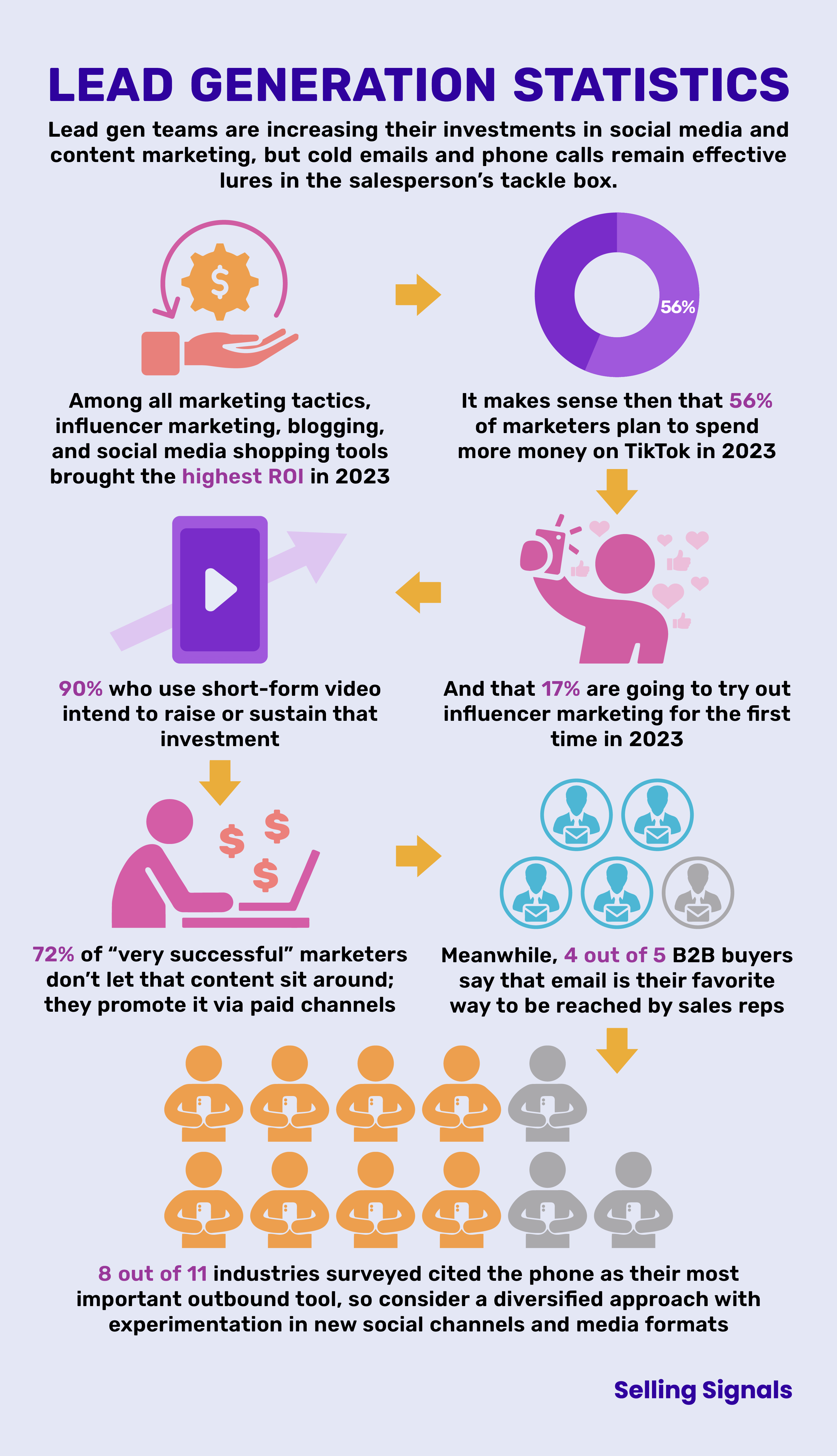-
News & Trends -
Sales -
Marketing Related Topics -
B2B Software Guides Related Topics -
Free Tools & Resources -
- About Us About Us


The lead generation landscape has undergone some big shifts over the last few years due to developments in buyer expectations, technology, and sales strategy. To help you stay abreast of the new trends, challenges, and tactics your peers are using, we’ve compiled a list of lead generation statistics from recent surveys and studies. Read on to gain a mountaintop view of the new terrain so you can adapt your lead generation strategy accordingly.

For a crash course in how to source leads effectively, check out our lead generation ultimate guide, where you’ll learn the different forms of lead generation, the step-by-step process for doing it, and the various software types involved.
When companies generate about 40–60% of leads from online sources, they experience the greatest growth. (Source: Hinge Research Institute)
71% of buyers who accept meetings with salespeople say that they want to hear from reps at the early research stage of their buying process. (Source: RAIN Group)
The highest ROI among all marketing tactics goes to influencer marketing, blogging, and social media shopping tools. (Source: HubSpot 2023 Marketing Report)
$3.2 billion is the estimated spend marketers will have allocated to digital lead generation by the end of 2023. (Source: Statista)
17% of marketers said they will try out influencer marketing for the first time in 2023. (Source: HubSpot 2023 Marketing Report)
Online lead generation in tandem with sales prospecting is often the best approach to generating leads, especially when the first contact is made early in the buyer’s research phase. For online lead generation, influencer marketing, blogging, and social media are the most effective channels this year in terms of ROI.
Less than 10% of marketers cited cold calling as their primary approach to lead generation. (Source: HubSpot)
Sellers must call a cold lead an average of 18 times to connect with them. (Source: Gartner)
8/11 industries surveyed cited the phone as their most important outbound tool. (Source: Orum)
21% of a sales rep’s prospecting time is spent doing cold calling introductions. (Source: Sopro 2023 Prospecting Report)
Sales reps double their cold call success rate (a booked meeting) by stating their reason for calling. (Source: Gong)
2% of cold calls result in a set meeting. (Source: LinkedIn)
Cold calling, when done improperly, is a time-intensive way to generate leads. However, with a refined approach, cold calling can result in a few meetings per day, while giving you immediate feedback on your value proposition and helping you locate the decision-maker. Consider using other methods like email and social selling to warm up leads before calling them.
Companies get $36 back for every dollar spent on email marketing. (Source: Litmus)
21.5% is the average open rate for marketing emails across all industries. (Source: CampaignMonitor)
80% of B2B buyers say that email is their favorite way to be reached by sales reps. (Source: RAIN Group)
44% of online shoppers say general email has influenced their purchasing decisions. (Source: Digital Commerce 360)
There’s a 30.5% jump in response rates when sellers personalize a cold email’s subject line. (Source: Backlinko)
On average, 7% of B2B cold emails receive a reply. (Source: Belkins 2023 Study)
306 emails must be sent, on average, to generate one quality B2B lead. (Source: Belkins 2023 Study)
Reply rates rise by 49% after the first follow-up email for cold B2B leads. (Source: Belkins 2023 Study)
11 AM - 12 PM boasts the highest open rates when cold emailing new leads. (Source: Sopro Prospecting Report)
Companies that use animated GIFs often or always in marketing emails saw a 21% increase in ROI. (Source: Litmus)
Cold emailing and email marketing continue to be powerful, high-ROI methods for generating leads across all industries. Make sure to personalize the emails, follow up with leads, and use email automation tools to send out a sufficient number of emails to generate leads.
There’s a 55% likelihood a lead will attend a work-related conference, as of 2022. (Source: Hinge Research Institute)
38% of top-performing B2B sales rep send their leads invitations to events. (Source: RAIN Group)
Social selling reps generate 45% more sales opportunities than reps with low Social Selling Index scores. (Source: LinkedIn)
14% of B2B marketers cited referrals as their best channel for lead generation. (Source: Ruler Analytics)
75.9% of event organizers think that in-person conferences will become increasingly important to their business’s success in the next several years. (Source: Bizzabo B2B Conferences Report)
90% of B2B marketers believe tech buyers are experiencing online event fatigue. (Source: Marketing Charts)
Many leads are tired of online events and hungry for in-person connection, making both networking at industry conferences and hosting your own events powerful strategies to meet and qualify new business leads. That said, social selling on LinkedIn is still a solid source of quality B2B leads.
56% of surveyed marketers are going to increase their investment in TikTok marketing in 2023. (Source: HubSpot 2023 Marketing Report)
74% of social media users want to see a consistent 1-2 posts per day from the businesses they follow. (Source: Sprout Social)
34% of the average SDR’s lead generation strategy is focused on social media approaches. (Source: Foundry Sales Development Report)
23% of marketers will increase their social media budget by 30-50% over the next three years, and 41% will increase it by even more than 50%. (Source: Sprout Social Report)
51% of respondents think that social media marketing has a major positive impact in how well they understand their buyers. (Source: Sprout Social Report)
Social media lead generation is growing in effectiveness and popularity; many marketers plan to increase their investment in the approach this year, especially in TikTok. Salespeople are also seeing success on social media, with SDRs spending 1/3 of their days using it for sales purposes.
82% of companies surveyed actively use content marketing. (Source: HubSpot)
90% of marketers who use short-form video intend to raise or sustain their investment in the format. (Source: HubSpot 2023 Marketing Report)
88% of marketers who use search engine optimization plan to raise or maintain their investment in the tactic. (Source: HubSpot 2023 Marketing Report)
79% of marketers denoted in the survey as “very successful” spend more than 10% of their total marketing budget on content. (Source: SemRush Content Marketing 2023 Report)
72% of “very successful” marketers use paid channels to promote their content. (Source: SemRush Content Marketing 2023 Report)
Only 3% of the “unsuccessful” marketers surveyed use a marketing automation tool. (Source: SemRush Content Marketing 2023 Report)
53% of B2B marketers cited webinars as the best lead generation method for sourcing high-quality leads. (Source: Demand Gen Report)
Content marketing is one of the best ways to organically source leads. Marketers have been finding success specifically with short-form video, webinars, and SEO.
37% of marketers stated that generating high-quality leads was one of their biggest challenges. (Source: Ruler Analytics)
45% of sellers stated that their biggest data challenge is incomplete data. (Source: LinkedIn)
86% of surveyed marketers said that changes to data privacy laws and regulations have affected their marketing strategy in the last year. (Source: HubSpot 2023 Marketing Report)
Five decision-makers are involved in the average B2B sales process these days. (Source: HubSpot 2024 Sales Trends Report)
42% of senior managers running sales development teams feel they do not have the right technology to support them. (Source: Foundry Sales Development Report)
31% of companies are having their BDR teams extensively qualify leads as a way to combat the top challenge of generating too many unqualified leads. (Source: Demand Gen Report)
Incomplete data, unqualified leads, too many decision-makers, and a lack of access to the right tools are all major roadblocks to salespeople’s ability to generate quality leads. Check out our lead generation process for a systematic approach that sidesteps these challenges.
43% of surveyed sales reps say that using AI to conduct research will have a positive impact on their performance. (Source: HubSpot 2024 Sales Trends Report)
89.9% of companies use at least two sources of lead contact data to satisfy the needs of their sales development team. (Source: Gartner)
45.3% of sales development teams planned to investigate dialing automation software in 2023. (Source: Gartner)
36.8% of surveyed companies intended to evaluate predictive analytics software in 2023, for lead generation and qualification purposes. (Source: Gartner)
53% of sales development teams support their reps with buyer intent data. (Source: Foundry Sales Development Report)
Only 38% of marketers have formalized plans to use AI within the next 12 months. (Source: VIB)
76% of top-performing sales reps say they conduct lead research before reaching out to leads. (Source: LinkedIn)
Successful sales reps are taking advantage of AI in their lead generation process, primarily for lead research and qualification. Dialing automation platforms and tools with predictive analytics and intent data are both courting major attention from sales development teams, and they’re worth looking into. Check out our article lead generation software to learn the different types of tools you may want to have in your lead gen stack.
Lead generation statistics are helpful for sales reps and marketers trying to bring their lead generation strategy into alignment with the times. Hopefully, you’ve found some new techniques to try out and some new technologies to explore. For greater insight into sales today, check out our article on sales statistics, where you’ll find stats about lead nurturing, deal closing, sales management, and other parts of the sales process.


Sam is a former SaaS sales rep turned freelance writer. He spent his career selling real estate technology to C-suite executives before switching over to blogging, where he now covers sales, marketing, and small business topics. Sam specializes in lead generation, lead nurturing, and deal closing articles for Selling Signals. When he’s not researching the latest sales trends, he’s either penning short stories, hiking, or reading in NYC’s Washington Square Park.

Selling Signals delivers actionable advice for sales and marketing professionals. Learn strategies that help you hit targets, strengthen customer relationships, and win more business. Get expert advice on lead generation, sales processes, CRM software, sales management, and account management directly to your inbox.
Property of TechnologyAdvice. © 2026 TechnologyAdvice. All Rights Reserved
Advertiser Disclosure: Some of the products that appear on this site are from companies from which TechnologyAdvice receives compensation. This compensation may impact how and where products appear on this site including, for example, the order in which they appear. TechnologyAdvice does not include all companies or all types of products available in the marketplace.